Brand Management Report: Brand Leveraging and Management
VerifiedAdded on 2023/01/09
|6
|1183
|60
Report
AI Summary
This report critically evaluates different techniques for brand leveraging, focusing on brand extension, brand collaboration, mergers, and acquisitions, and brand reinforcement. It analyzes the application of these techniques, particularly in the context of the Dyson brand, highlighting the potential benefits of mergers and acquisitions for brand extension and increased leverage. The report also examines brand management at domestic and global levels, emphasizing the importance of brand awareness, market share, and purchasing intent. It explores how Dyson can improve its global presence by strategically managing these factors. The report concludes with a discussion of the key considerations for effective brand management at both national and international levels and the importance of adapting to changing trends.
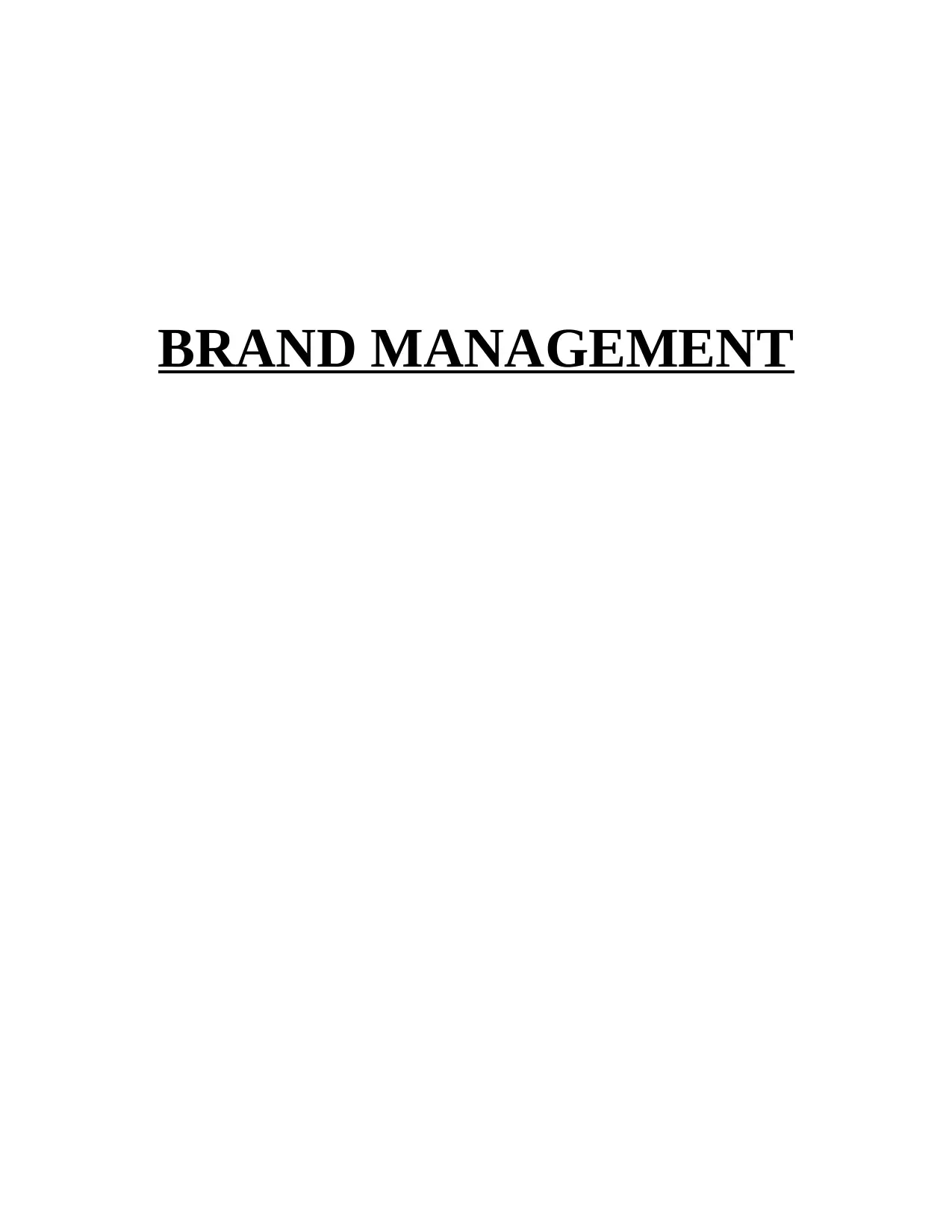
BRAND MANAGEMENT
Paraphrase This Document
Need a fresh take? Get an instant paraphrase of this document with our AI Paraphraser
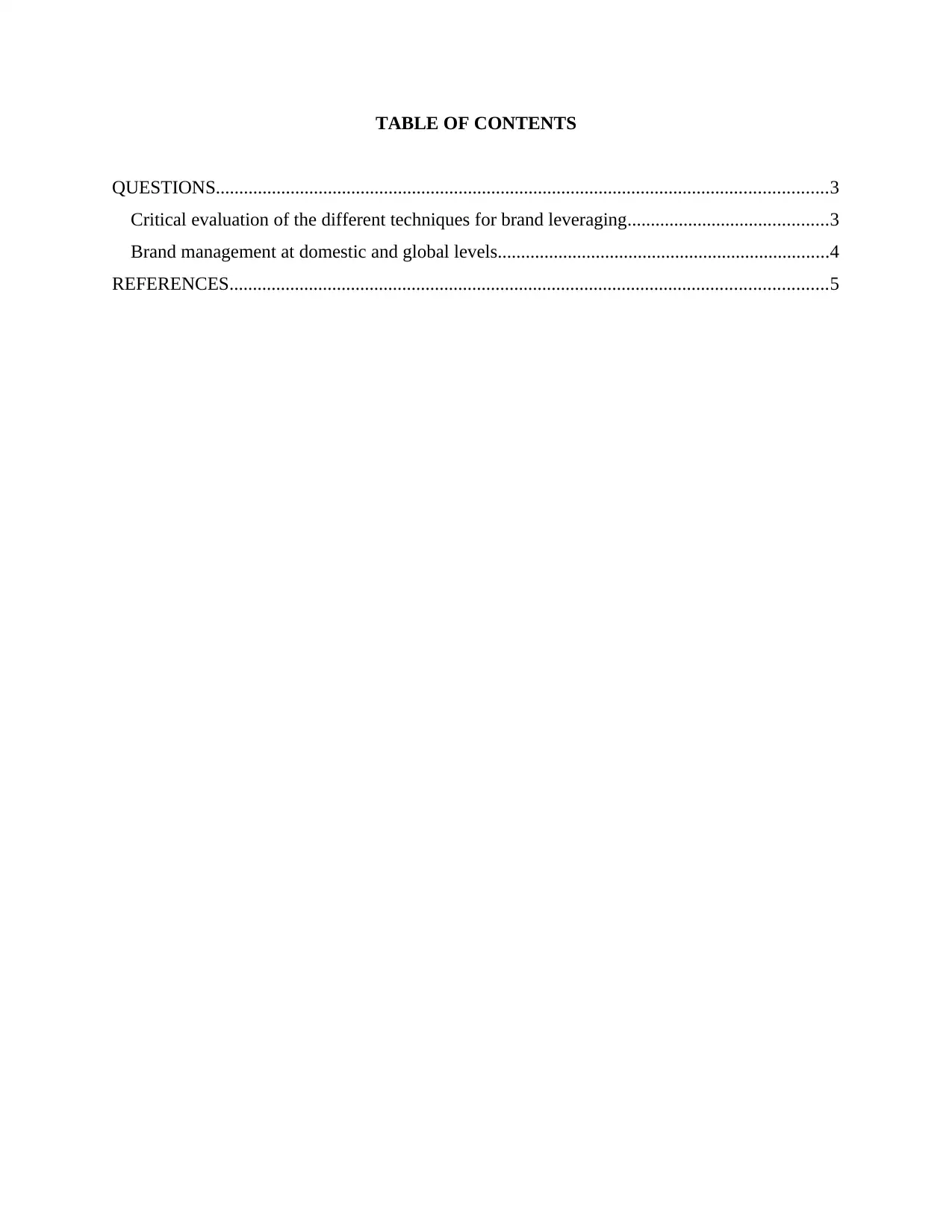
TABLE OF CONTENTS
QUESTIONS...................................................................................................................................3
Critical evaluation of the different techniques for brand leveraging...........................................3
Brand management at domestic and global levels.......................................................................4
REFERENCES................................................................................................................................5
QUESTIONS...................................................................................................................................3
Critical evaluation of the different techniques for brand leveraging...........................................3
Brand management at domestic and global levels.......................................................................4
REFERENCES................................................................................................................................5
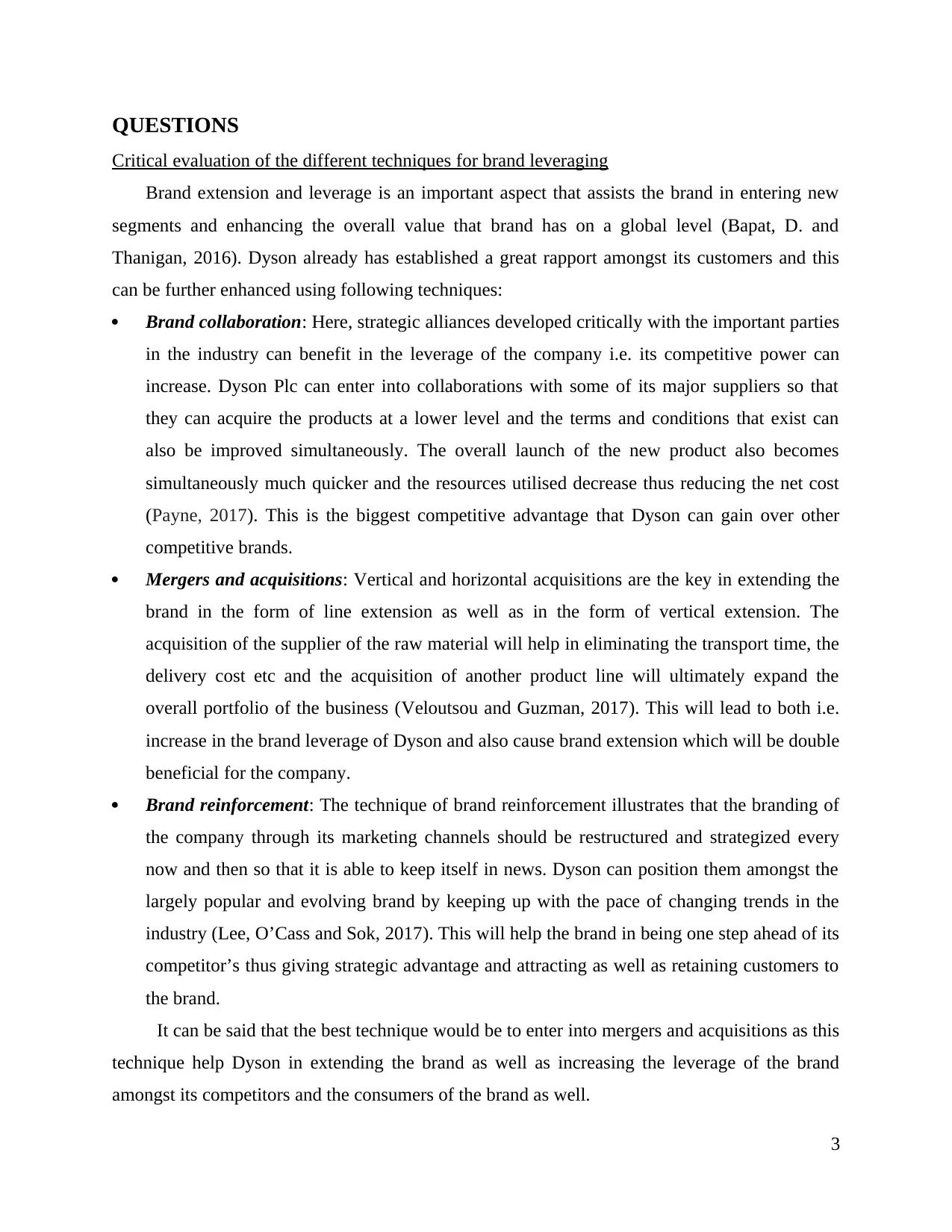
QUESTIONS
Critical evaluation of the different techniques for brand leveraging
Brand extension and leverage is an important aspect that assists the brand in entering new
segments and enhancing the overall value that brand has on a global level (Bapat, D. and
Thanigan, 2016). Dyson already has established a great rapport amongst its customers and this
can be further enhanced using following techniques:
Brand collaboration: Here, strategic alliances developed critically with the important parties
in the industry can benefit in the leverage of the company i.e. its competitive power can
increase. Dyson Plc can enter into collaborations with some of its major suppliers so that
they can acquire the products at a lower level and the terms and conditions that exist can
also be improved simultaneously. The overall launch of the new product also becomes
simultaneously much quicker and the resources utilised decrease thus reducing the net cost
(Payne, 2017). This is the biggest competitive advantage that Dyson can gain over other
competitive brands.
Mergers and acquisitions: Vertical and horizontal acquisitions are the key in extending the
brand in the form of line extension as well as in the form of vertical extension. The
acquisition of the supplier of the raw material will help in eliminating the transport time, the
delivery cost etc and the acquisition of another product line will ultimately expand the
overall portfolio of the business (Veloutsou and Guzman, 2017). This will lead to both i.e.
increase in the brand leverage of Dyson and also cause brand extension which will be double
beneficial for the company.
Brand reinforcement: The technique of brand reinforcement illustrates that the branding of
the company through its marketing channels should be restructured and strategized every
now and then so that it is able to keep itself in news. Dyson can position them amongst the
largely popular and evolving brand by keeping up with the pace of changing trends in the
industry (Lee, O’Cass and Sok, 2017). This will help the brand in being one step ahead of its
competitor’s thus giving strategic advantage and attracting as well as retaining customers to
the brand.
It can be said that the best technique would be to enter into mergers and acquisitions as this
technique help Dyson in extending the brand as well as increasing the leverage of the brand
amongst its competitors and the consumers of the brand as well.
3
Critical evaluation of the different techniques for brand leveraging
Brand extension and leverage is an important aspect that assists the brand in entering new
segments and enhancing the overall value that brand has on a global level (Bapat, D. and
Thanigan, 2016). Dyson already has established a great rapport amongst its customers and this
can be further enhanced using following techniques:
Brand collaboration: Here, strategic alliances developed critically with the important parties
in the industry can benefit in the leverage of the company i.e. its competitive power can
increase. Dyson Plc can enter into collaborations with some of its major suppliers so that
they can acquire the products at a lower level and the terms and conditions that exist can
also be improved simultaneously. The overall launch of the new product also becomes
simultaneously much quicker and the resources utilised decrease thus reducing the net cost
(Payne, 2017). This is the biggest competitive advantage that Dyson can gain over other
competitive brands.
Mergers and acquisitions: Vertical and horizontal acquisitions are the key in extending the
brand in the form of line extension as well as in the form of vertical extension. The
acquisition of the supplier of the raw material will help in eliminating the transport time, the
delivery cost etc and the acquisition of another product line will ultimately expand the
overall portfolio of the business (Veloutsou and Guzman, 2017). This will lead to both i.e.
increase in the brand leverage of Dyson and also cause brand extension which will be double
beneficial for the company.
Brand reinforcement: The technique of brand reinforcement illustrates that the branding of
the company through its marketing channels should be restructured and strategized every
now and then so that it is able to keep itself in news. Dyson can position them amongst the
largely popular and evolving brand by keeping up with the pace of changing trends in the
industry (Lee, O’Cass and Sok, 2017). This will help the brand in being one step ahead of its
competitor’s thus giving strategic advantage and attracting as well as retaining customers to
the brand.
It can be said that the best technique would be to enter into mergers and acquisitions as this
technique help Dyson in extending the brand as well as increasing the leverage of the brand
amongst its competitors and the consumers of the brand as well.
3
⊘ This is a preview!⊘
Do you want full access?
Subscribe today to unlock all pages.

Trusted by 1+ million students worldwide
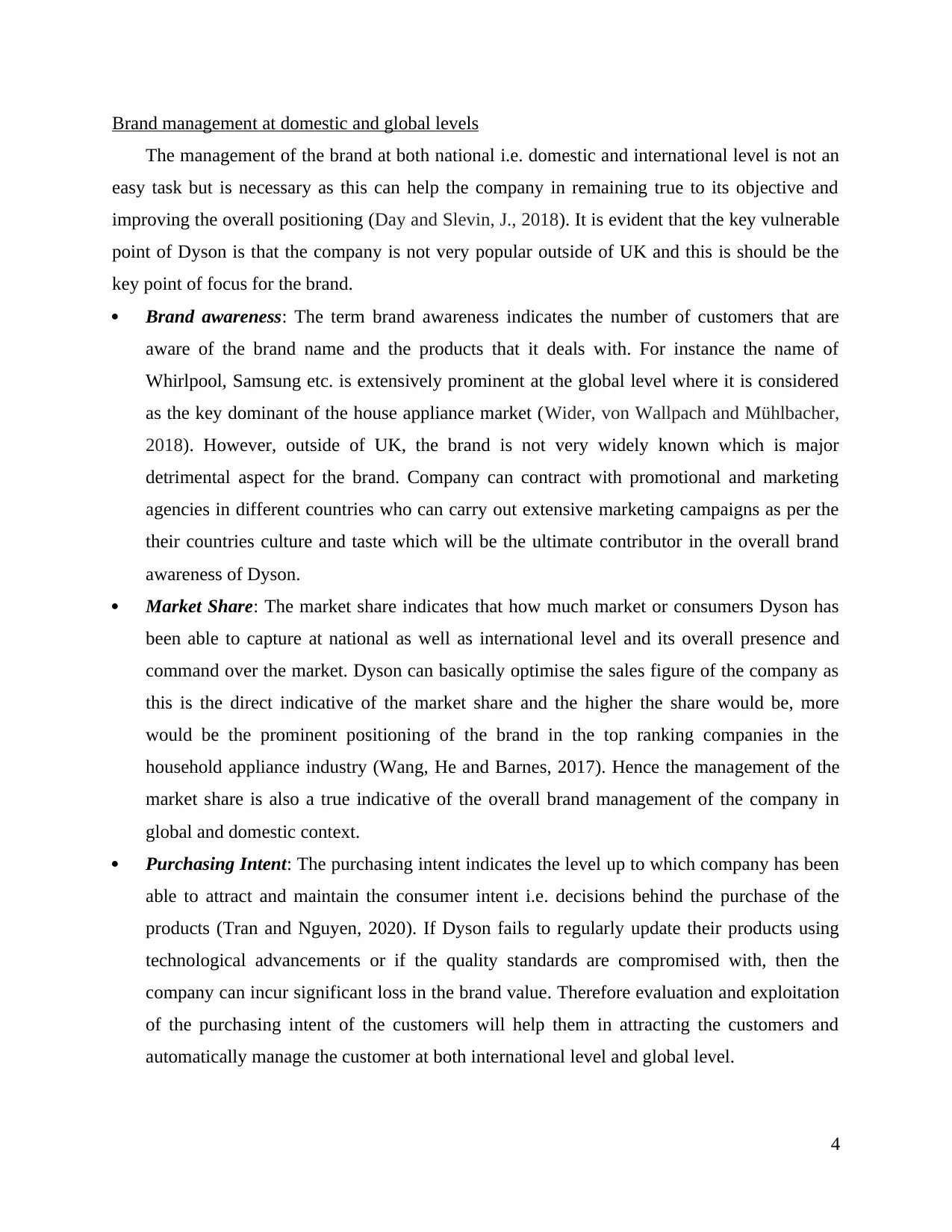
Brand management at domestic and global levels
The management of the brand at both national i.e. domestic and international level is not an
easy task but is necessary as this can help the company in remaining true to its objective and
improving the overall positioning (Day and Slevin, J., 2018). It is evident that the key vulnerable
point of Dyson is that the company is not very popular outside of UK and this is should be the
key point of focus for the brand.
Brand awareness: The term brand awareness indicates the number of customers that are
aware of the brand name and the products that it deals with. For instance the name of
Whirlpool, Samsung etc. is extensively prominent at the global level where it is considered
as the key dominant of the house appliance market (Wider, von Wallpach and Mühlbacher,
2018). However, outside of UK, the brand is not very widely known which is major
detrimental aspect for the brand. Company can contract with promotional and marketing
agencies in different countries who can carry out extensive marketing campaigns as per the
their countries culture and taste which will be the ultimate contributor in the overall brand
awareness of Dyson.
Market Share: The market share indicates that how much market or consumers Dyson has
been able to capture at national as well as international level and its overall presence and
command over the market. Dyson can basically optimise the sales figure of the company as
this is the direct indicative of the market share and the higher the share would be, more
would be the prominent positioning of the brand in the top ranking companies in the
household appliance industry (Wang, He and Barnes, 2017). Hence the management of the
market share is also a true indicative of the overall brand management of the company in
global and domestic context.
Purchasing Intent: The purchasing intent indicates the level up to which company has been
able to attract and maintain the consumer intent i.e. decisions behind the purchase of the
products (Tran and Nguyen, 2020). If Dyson fails to regularly update their products using
technological advancements or if the quality standards are compromised with, then the
company can incur significant loss in the brand value. Therefore evaluation and exploitation
of the purchasing intent of the customers will help them in attracting the customers and
automatically manage the customer at both international level and global level.
4
The management of the brand at both national i.e. domestic and international level is not an
easy task but is necessary as this can help the company in remaining true to its objective and
improving the overall positioning (Day and Slevin, J., 2018). It is evident that the key vulnerable
point of Dyson is that the company is not very popular outside of UK and this is should be the
key point of focus for the brand.
Brand awareness: The term brand awareness indicates the number of customers that are
aware of the brand name and the products that it deals with. For instance the name of
Whirlpool, Samsung etc. is extensively prominent at the global level where it is considered
as the key dominant of the house appliance market (Wider, von Wallpach and Mühlbacher,
2018). However, outside of UK, the brand is not very widely known which is major
detrimental aspect for the brand. Company can contract with promotional and marketing
agencies in different countries who can carry out extensive marketing campaigns as per the
their countries culture and taste which will be the ultimate contributor in the overall brand
awareness of Dyson.
Market Share: The market share indicates that how much market or consumers Dyson has
been able to capture at national as well as international level and its overall presence and
command over the market. Dyson can basically optimise the sales figure of the company as
this is the direct indicative of the market share and the higher the share would be, more
would be the prominent positioning of the brand in the top ranking companies in the
household appliance industry (Wang, He and Barnes, 2017). Hence the management of the
market share is also a true indicative of the overall brand management of the company in
global and domestic context.
Purchasing Intent: The purchasing intent indicates the level up to which company has been
able to attract and maintain the consumer intent i.e. decisions behind the purchase of the
products (Tran and Nguyen, 2020). If Dyson fails to regularly update their products using
technological advancements or if the quality standards are compromised with, then the
company can incur significant loss in the brand value. Therefore evaluation and exploitation
of the purchasing intent of the customers will help them in attracting the customers and
automatically manage the customer at both international level and global level.
4
Paraphrase This Document
Need a fresh take? Get an instant paraphrase of this document with our AI Paraphraser
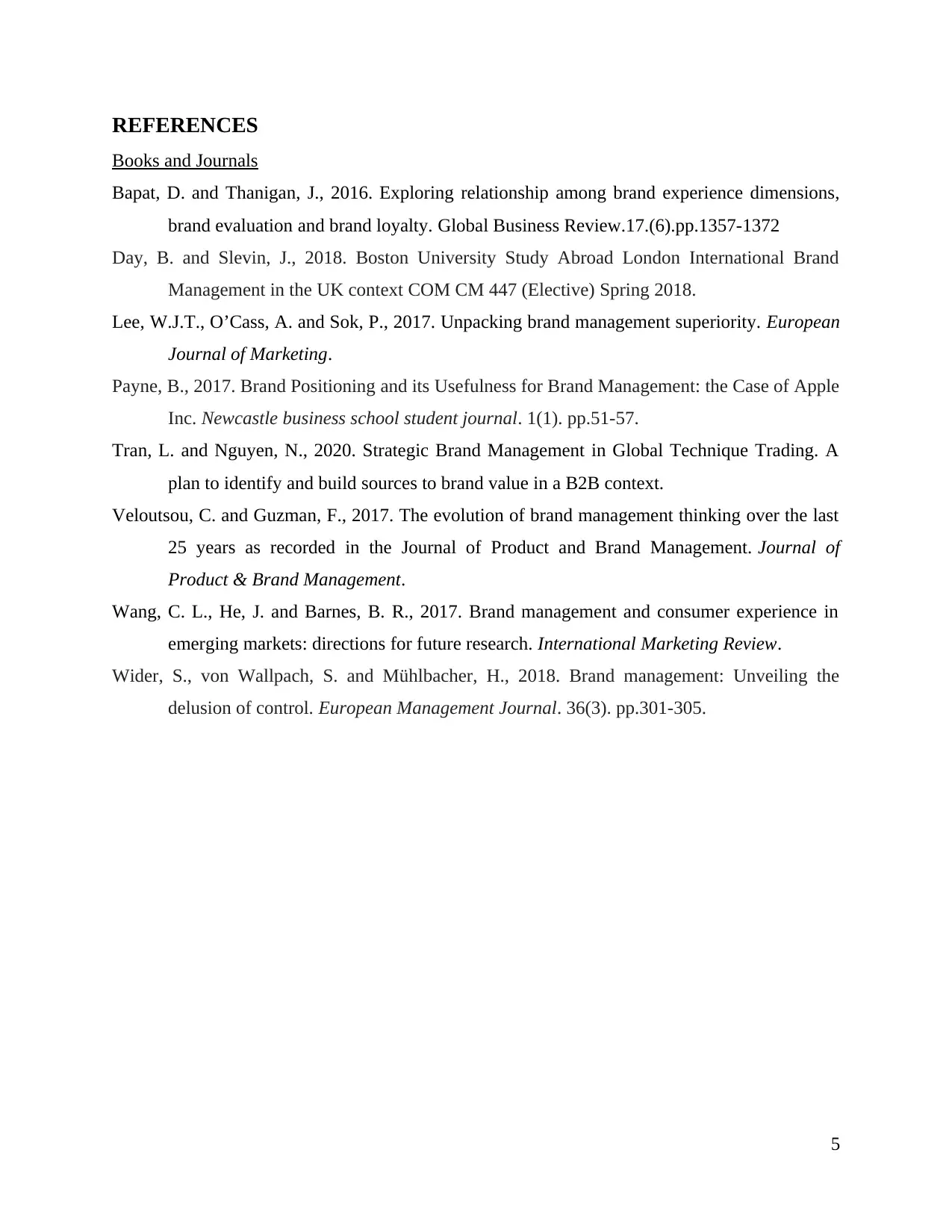
REFERENCES
Books and Journals
Bapat, D. and Thanigan, J., 2016. Exploring relationship among brand experience dimensions,
brand evaluation and brand loyalty. Global Business Review.17.(6).pp.1357-1372
Day, B. and Slevin, J., 2018. Boston University Study Abroad London International Brand
Management in the UK context COM CM 447 (Elective) Spring 2018.
Lee, W.J.T., O’Cass, A. and Sok, P., 2017. Unpacking brand management superiority. European
Journal of Marketing.
Payne, B., 2017. Brand Positioning and its Usefulness for Brand Management: the Case of Apple
Inc. Newcastle business school student journal. 1(1). pp.51-57.
Tran, L. and Nguyen, N., 2020. Strategic Brand Management in Global Technique Trading. A
plan to identify and build sources to brand value in a B2B context.
Veloutsou, C. and Guzman, F., 2017. The evolution of brand management thinking over the last
25 years as recorded in the Journal of Product and Brand Management. Journal of
Product & Brand Management.
Wang, C. L., He, J. and Barnes, B. R., 2017. Brand management and consumer experience in
emerging markets: directions for future research. International Marketing Review.
Wider, S., von Wallpach, S. and Mühlbacher, H., 2018. Brand management: Unveiling the
delusion of control. European Management Journal. 36(3). pp.301-305.
5
Books and Journals
Bapat, D. and Thanigan, J., 2016. Exploring relationship among brand experience dimensions,
brand evaluation and brand loyalty. Global Business Review.17.(6).pp.1357-1372
Day, B. and Slevin, J., 2018. Boston University Study Abroad London International Brand
Management in the UK context COM CM 447 (Elective) Spring 2018.
Lee, W.J.T., O’Cass, A. and Sok, P., 2017. Unpacking brand management superiority. European
Journal of Marketing.
Payne, B., 2017. Brand Positioning and its Usefulness for Brand Management: the Case of Apple
Inc. Newcastle business school student journal. 1(1). pp.51-57.
Tran, L. and Nguyen, N., 2020. Strategic Brand Management in Global Technique Trading. A
plan to identify and build sources to brand value in a B2B context.
Veloutsou, C. and Guzman, F., 2017. The evolution of brand management thinking over the last
25 years as recorded in the Journal of Product and Brand Management. Journal of
Product & Brand Management.
Wang, C. L., He, J. and Barnes, B. R., 2017. Brand management and consumer experience in
emerging markets: directions for future research. International Marketing Review.
Wider, S., von Wallpach, S. and Mühlbacher, H., 2018. Brand management: Unveiling the
delusion of control. European Management Journal. 36(3). pp.301-305.
5

6
⊘ This is a preview!⊘
Do you want full access?
Subscribe today to unlock all pages.

Trusted by 1+ million students worldwide
1 out of 6
Related Documents
Your All-in-One AI-Powered Toolkit for Academic Success.
+13062052269
info@desklib.com
Available 24*7 on WhatsApp / Email
![[object Object]](/_next/static/media/star-bottom.7253800d.svg)
Unlock your academic potential
Copyright © 2020–2025 A2Z Services. All Rights Reserved. Developed and managed by ZUCOL.





